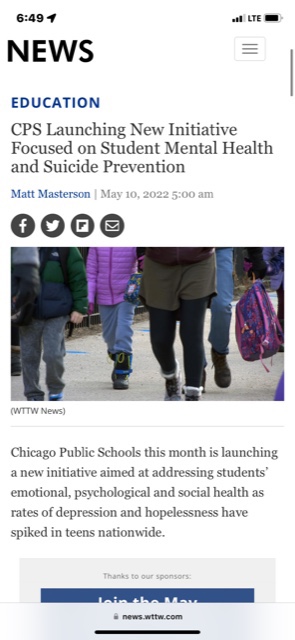As part of Mental Health Awareness Month, CPS will become the first school district in the U.S. to participate in the “Please Stay” initiative, which is focused on suicide prevention and prioritizing the mental health of students dealing with increased levels of anxiety and stress.
I remember a time when Time Magazine published an article hypothesizing that children could experience depression and mania even as a child beyond normal child behavior. I remember reading that, I was very young reader at the time of TIME, I think it was 4th grade. I remember being angry that something so obvious to me was an hypothesis.
“Since we came back from remote learning, kids are different: They’re different and they’re affected with issues we can’t even anticipate, and in a way, there’s almost a contagious aspect to this,” Amundsen High School Principal Anna Pavichevich told WTTW News. “It is so important that we take steps now. This initiative CPS is putting forth has come at the perfect time.”
I imagine more kids have experience given the CoVid generation of Z. This is crucial.
The “Please Stay” program was developed by the Born This Way Foundation and Find Your Anchor and seeks to better educate students in grades 7-12 about mental health by facilitating peer-to-peer conversations and connecting teens with any mental health resources they may need.
I also recommend NAMI for resources. They have local chapters across the county.
Michael Roy, the Training and Prevention team lead in CPS, said the district has tried to emphasize youth voices and leadership so students can hear from other teens about the mental health concerns and challenges they face.
Group talk therapy can be incredibly successful in clinical settings. Read on:
CPS distributed materials to teachers, counselors and school leaders for facilitating classroom conversations on self-care and helping students to find “anchors” — things like a favorite activity or meal they can use to steady themselves in times of stress.
Participating students are also asked to take a pledge in which they promise to reach out for support if and when they need it.
Earlier this year, the Centers for Disease Control and Prevention published a study that found 44% of high schoolers in the U.S. had reported persistent feelings of sadness or hopelessness.
Pavichevich said it’s “soul-crushing” to see students dealing with those issues on a day-to-day basis, but those issues also extend beyond the classroom and have become a “community problem.”
“When we’re dealing with so much sadness and so much depression and anxiety, I go home feeling sad and anxious,” she said. “Teachers go home feeling sad and anxious, so this is something that’s pervasive throughout communities now.”
As part of the new initiative, CPS is also putting an emphasis on having school leaders identify resources for students within their buildings so they have people they can talk to every day they need to.
Late last month, CPS announced plans to expand a pilot program with Lurie Children’s Hospital that will put a behavioral health team in every district-run school in order to better identify and address students in need of mental health support.
Roy said CPS is also piloting a program in some schools called Teen Mental Health First Aid, which is a peer-to-peer support program that helps high schoolers learn how to understand and respond to the signs of mental health or substance-use issues.
CPS schools will begin rolling out the initiative over the final weeks of the current school year.
“This is just an incredibly important campaign right now,” Roy said. “We know there are young people dealing with depression and anxiety and those issues have really grown during the pandemic.”
Looking back, I would refer to much of this as a critical element in what I believe is necessary; what is referred to as “wrap around” support. Students should learn in an environment where their essential needs are met. Providing safety and care: Isn’t that the least we can do? Nice first step, CPS. And good reporting, Matt Masterson.
Contact Matt Masterson: @ByMattMasterson| mmasterson@wttw.com | (773) 509-5431
